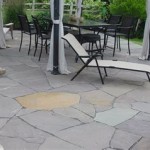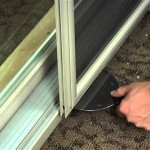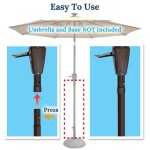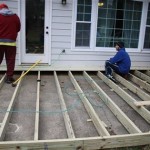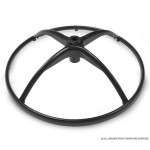How To Secure a Patio Umbrella Base
A patio umbrella provides essential shade and comfort during outdoor gatherings, protecting individuals from harsh sunlight and creating a more pleasant environment for relaxation and entertainment. However, the effectiveness of a patio umbrella hinges significantly on the stability of its base. An unstable base can lead to the umbrella tipping over, particularly in windy conditions, potentially causing damage to property and posing a safety risk to individuals nearby. Securing a patio umbrella base is therefore paramount for ensuring both the longevity of the umbrella and the safety of the outdoor space.
This article will detail various methods and considerations for securing a patio umbrella base, ensuring it remains firmly anchored even in adverse weather. The principles outlined will cover selecting the right type of base, adding weight, and employing various anchoring techniques to achieve optimal stability.
Selecting the Appropriate Patio Umbrella Base
The initial step in securing a patio umbrella involves choosing a base that is adequately sized and weighted for the umbrella it will support. Several factors influence this decision, including the size and style of the umbrella, the prevailing wind conditions in the area, and the type of surface where the umbrella will be placed.
Umbrella Size and Style: Larger umbrellas, particularly cantilever or offset models, require significantly heavier and more robust bases than smaller, center-pole umbrellas. The larger the canopy, the greater the surface area exposed to the wind, thus necessitating a more substantial base to prevent tipping. Cantilever umbrellas, due to their offset design, exert a considerable amount of leverage on the base, making a heavier base crucial for stability.
Manufacturers typically provide recommendations regarding the minimum base weight required for specific umbrella models. Adhering to these recommendations is critical for ensuring the umbrella remains stable under normal conditions. In cases where the manufacturer’s recommendations are unavailable or unclear, a general guideline is to use a base weighing at least 50 pounds for umbrellas up to 7 feet in diameter, increasing the weight proportionally for larger umbrellas. For cantilever umbrellas, weights of 100 pounds or more are frequently necessary.
Wind Conditions: The average wind speed in the area where the umbrella will be used is a significant determinant of the required base weight. Regions prone to high winds necessitate heavier bases and potentially additional anchoring measures. Coastal areas, elevated locations, and areas with open exposure are particularly susceptible to strong winds and require careful consideration in selecting and securing the umbrella base.
It is prudent to err on the side of caution and choose a heavier base than strictly required, especially if the umbrella is intended for use in an area with potentially unpredictable weather patterns. Overestimating the required base weight will provide an added margin of safety and prevent the umbrella from tipping over during unexpected gusts of wind.
Surface Type: The type of surface on which the umbrella base will be placed also influences the selection process. Hard surfaces, such as concrete patios or decks, generally provide a stable platform and allow for the use of bases with a relatively smaller footprint. Softer surfaces, such as lawns or gravel, may require bases with a wider footprint to prevent sinking or tilting. Furthermore, certain anchoring techniques, such as using ground stakes, are only applicable for use on soft surfaces.
Consideration should also be given to the texture and material of the surface. Slippery surfaces, such as polished concrete or tile, may require the use of non-slip pads or mats beneath the base to improve traction and prevent movement. Uneven surfaces should be leveled before placing the umbrella base to ensure stability.
Various types of umbrella bases are available, each offering different features and advantages. Common types include: * Standard Weighted Bases: These bases are typically made of concrete, steel, or cast iron and are pre-weighted to provide stability. They are suitable for smaller umbrellas and areas with moderate wind conditions. * Fillable Bases: These bases are designed to be filled with water or sand to increase their weight. They offer a convenient and cost-effective option for adding weight to a lighter base. * Rolling Bases: These bases feature wheels that allow for easy movement of the umbrella. They are ideal for situations where the umbrella needs to be repositioned frequently. * In-Ground Bases: These bases are permanently installed in the ground, providing maximum stability. They are suitable for locations where the umbrella will remain in a fixed position.
Adding Weight to the Patio Umbrella Base
Once an appropriate base has been selected, additional weight may be necessary, particularly in areas prone to high winds or when using larger umbrellas. Various methods can be employed to add weight to the base, enhancing its stability and preventing tipping.
Fillable Weights: Fillable weights are a versatile option for adding weight to the umbrella base. These weights are typically made of durable plastic and can be filled with water or sand. Sand generally provides a higher density and therefore a greater weight per volume compared to water. However, water is easier to handle and dispose of, making it a convenient option for temporary use or for situations where the base needs to be moved frequently.
Fillable weights are available in various shapes and sizes, allowing for flexibility in placement and distribution of weight around the base. Some models are designed to wrap around the base, while others can be stacked on top of it. When using fillable weights, it is important to ensure they are securely fastened to the base to prevent them from shifting or falling off.
Sandbags: Sandbags offer another effective method for adding weight to the umbrella base. They are relatively inexpensive and easy to use. Sandbags can be placed around the base, distributing the weight evenly and providing additional stability. It is important to use durable sandbags made of weather-resistant materials to prevent them from deteriorating or leaking. The sandbags should be securely tied or fastened to prevent them from being blown away by the wind.
Concrete Pavers: Concrete pavers or bricks can be used to add weight to the umbrella base. They are readily available and relatively inexpensive. Pavers can be arranged around the base, creating a stable and attractive platform. It is important to choose pavers of sufficient weight and size to provide adequate stability. The pavers should be arranged in a manner that distributes the weight evenly around the base.
Custom Weights: For a more customized solution, weights can be custom-made using concrete or other heavy materials. This approach allows for precise control over the weight and dimensions of the added weight. Custom weights can be designed to seamlessly integrate with the existing umbrella base, creating a more aesthetically pleasing and functional solution. However, custom weights may require more effort and expense compared to other options.
Employing Anchoring Techniques
In addition to selecting an appropriate base and adding weight, anchoring techniques can be used to further secure the patio umbrella, particularly in areas with strong winds. Anchoring techniques involve physically attaching the umbrella base to the ground or to a nearby structure, providing additional resistance against tipping.
Ground Stakes: Ground stakes are a common anchoring technique for securing patio umbrellas on soft surfaces, such as lawns or gravel. Ground stakes are typically made of metal or plastic and are driven into the ground around the perimeter of the umbrella base. The stakes are then connected to the base using ropes, straps, or chains. The stakes provide additional resistance against tipping by anchoring the base to the ground.
The effectiveness of ground stakes depends on the type of soil and the depth to which the stakes are driven. Loose or sandy soil may not provide sufficient holding power, requiring longer stakes or additional anchoring measures. The stakes should be driven deep enough to ensure they are firmly anchored in the ground. It is also important to ensure the ropes, straps, or chains connecting the stakes to the base are securely fastened. Regular inspection and maintenance of the stakes and connections are necessary to ensure their continued effectiveness.
Bolting to a Deck or Patio: For umbrellas placed on decks or patios, the base can be bolted directly to the surface. This method provides a highly secure anchor, particularly on hard surfaces such as concrete or wood. Bolting the base to the surface requires drilling holes in the surface and attaching the base using bolts and washers. It is important to use appropriate hardware that is compatible with the type of surface being bolted to.
Before bolting the base, it is important to ensure the surface is strong enough to support the weight of the umbrella and the forces exerted by the wind. Decks constructed of composite materials may require additional reinforcement to ensure adequate support. It is also important to consider the aesthetic impact of bolting the base to the surface, as the holes will be visible when the umbrella is removed.
Using a Table: If the patio umbrella is used with a table that has a hole designed for an umbrella, the table itself can provide additional stability. The umbrella pole is inserted through the hole in the table, and the weight of the table helps to stabilize the umbrella. However, it is important to ensure the table is sufficiently heavy and stable to provide adequate support. Lightweight or flimsy tables may not provide enough resistance against tipping. In windy conditions, it may be necessary to add additional weight to the table or to employ other anchoring techniques to further secure the umbrella.
Securing to a Wall or Post: In some cases, it may be possible to secure the patio umbrella to a nearby wall or post. This can be achieved using brackets, clamps, or straps. The umbrella pole is attached to the wall or post, providing additional support and resistance against tipping. When securing the umbrella to a wall or post, it is important to ensure the attachment is strong enough to withstand the forces exerted by the wind. The wall or post should also be structurally sound and capable of supporting the weight of the umbrella.
When choosing and implementing any of these techniques, it is important to consider the specific characteristics of the umbrella, the environment, and the intended use. Proper implementation of these methods will ensure a safe and enjoyable outdoor experience.

How To Weigh Down And Secure A Cantilever Umbrella Outsidemodern Outdoor Stand Offset

Gardenised Umbrella Clamp For Fence Post Railing Bleachers Or Benches Strong And Durable Keeps Secure In Any Weather 3 Pack Qi004404 The Home Depot

Sumbel Large 10 X10 Double Top Cantilever Patio Umbrella

Westin Outdoor Plastic Umbrella Base Weight For Patio Water Or Sand Fillable Broe Com

Square Brown Umbrella Base 42lb

Sunnydaze Modern Geometric Cast Iron Patio Umbrella Base 17 Square

Us Weight 40 Pound Umbrella Base Designed To Be Used With A Patio Table Broe Fub40bz Zoro

18in Rustic Patio Umbrella Base Best Choice S

Us Weight 22lb Patio Umbrella Base 17 5 Inch Broe Fub22bz The Home Depot

Black Umbrella Base 24lb

